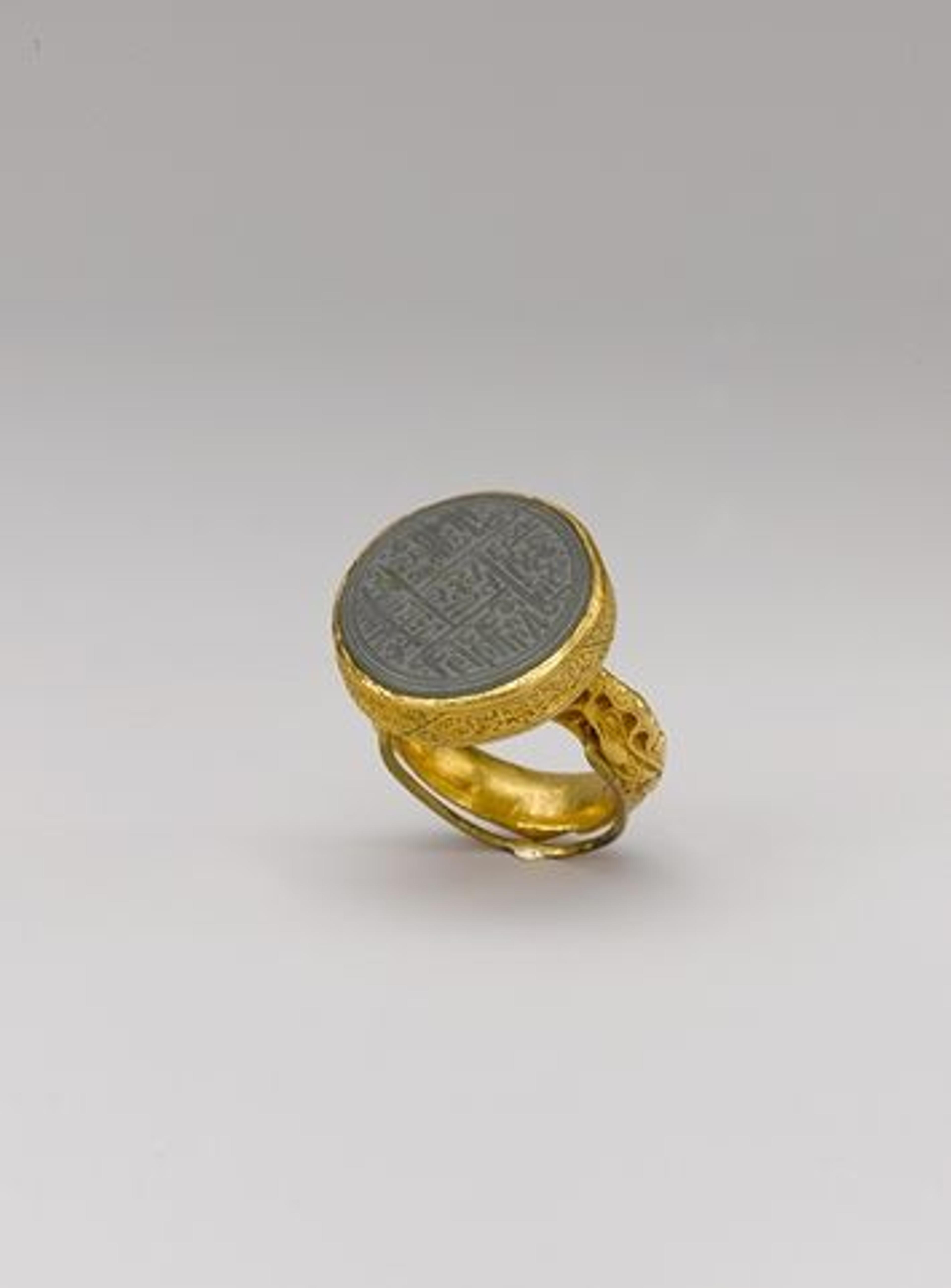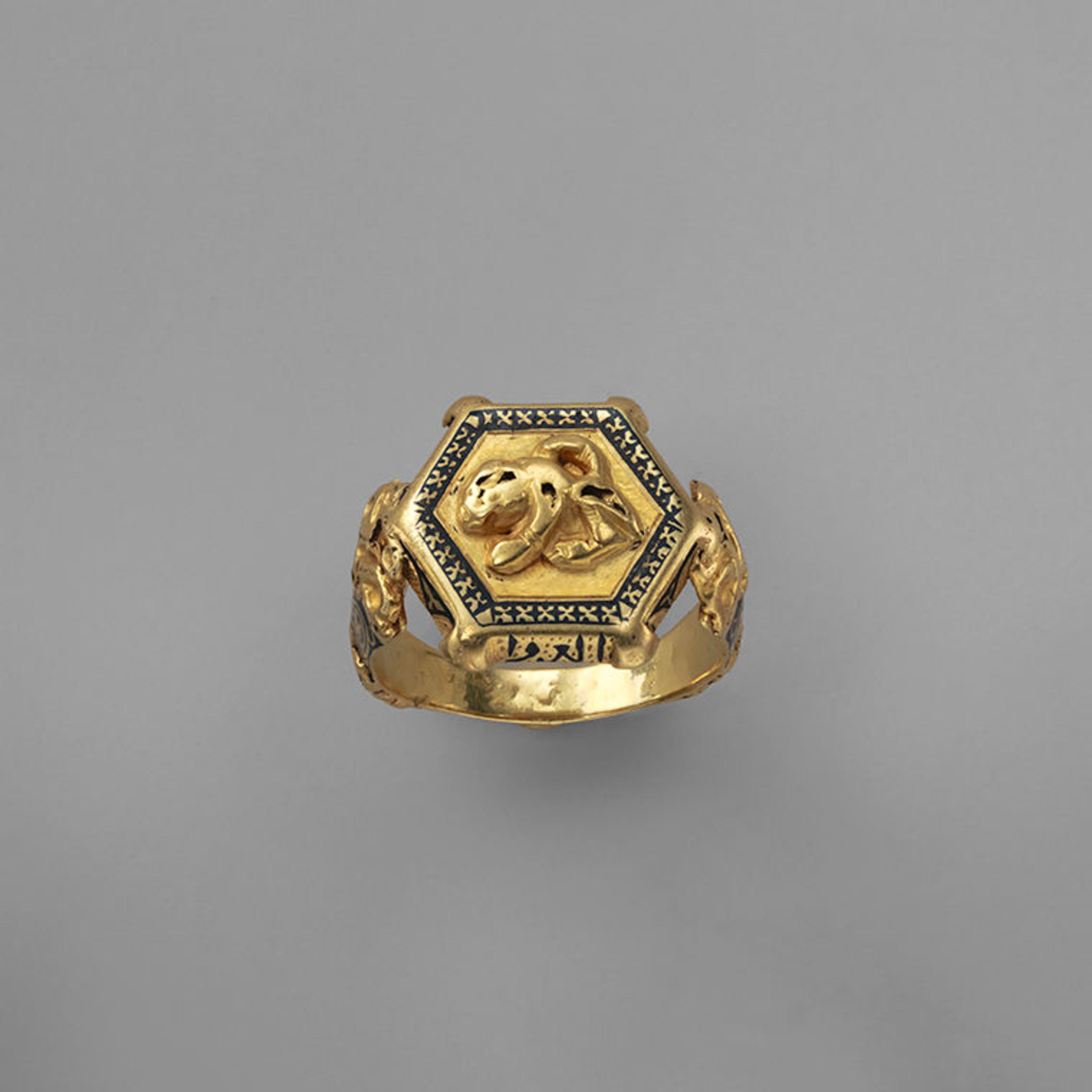
I love art history because a lot of information can be gathered about a culture by looking at its artwork. Jewelry in particular tells art historians what a culture valued. We can look at what people chose to adorn themselves with to understand who those people were. I'm interested in apotropaic rings because, as a metalsmith, I am intrigued that rings were used not just as decoration, but for a particular purpose.
Left: Seal ring with inscription, late 15th–early 16th century. Attributed to Iran or Central Asia. Gold, cast and chased; nephrite, carved, H. 1 3/8 in. (3.5 cm). The Metropolitan Museum of Art, New York, Rogers Fund, 1912 (12.224.6)
"Apotropaic" means having the power to ward off evil influences or bad luck. Presently, rings are worn to show marriage status or just as a fashion statement. But rings at other times were coveted by peoples because they believed that with them, they would be at a spiritual advantage. I find it interesting that many cultures—including Greek, Egyptian, and Iranian cultures—had this in common.
The ring shown above was made in the late fifteenth to early sixteenth century and is attributed to Iran or Central Asia. It is made from gold and carved nephrite, a type of jade. The inscription on the ring contains religious verses written in mirror reverse, so it may have once been used as a seal. One part of the inscribed prayer says: "Call upon 'Ali, the revealer of miracles made manifest, You will find him a comfort to you in times of misfortune / All care and sorrows will disappear through your companionship." This is a call to 'Ali ibn Abi Talib, son-in-law of the Prophet Muhammad. Additional smaller inscriptions have prayer-like verses that may have been meant to protect the wearer.

Ring with chameleon (Yawiige), 19th–20th century. Burkina Faso or Côte d'Ivoire or Mali. Senufo. Brass, 1 1/2 x 1 1/8 x 1 1/8 in. (3.8 x 2.8 x 2.8 cm). The Metropolitan Museum of Art, New York, The Bryce Holcombe Collection of African Decorative Art, Bequest of Bryce Holcombe, 1984 (1986.478.29)
This ring was made in the nineteenth or twentieth century by a Senufo metalsmith in present-day Burkina Faso, Côte d'Ivoire, or Mali, in West Africa. Among Senufo peoples, individuals who are ill or have problems visit diviners to help them. It is believed that diviners contact spiritual intermediaries that help them solve problems. A possible recommendation by a diviner is to have a yawiige (a word that mean "something that follows you") created by a local blacksmith. A yawiige can be an ornament such as a pendant, anklet, or ring that keeps the wearer safe from harm. Chameleons like the one featured on this ring are often found in Senufo arts because they are believed to have existed from the beginning of time and are considered to be intermediaries between human and spirit realms.

Ring with seated lion, 12th century. Attributed to Iran. Gold; inlaid with black organic compound, 7/8 x 13/16 in. (2.2 x 2.1 cm). The Metropolitan Museum of Art, New York, Purchase, Friends of Islamic Art Gifts, 2007 (2007.344)
This ring is attributed to Iran and was made in the twelfth century. It is made of gold and black organic compound. The molded lion on the ring has its tail up and its head down and is surrounded by an inscription that says "glory and prosperity." For this reason, it is believed to be a symbol of power and protection. Lions in similar poses are also on other objects in the Museum's collection, including some ewers. The inscription is filled in with niello, a mixture used to fill engraved designs in metal.
These are just three of the rings in The Met collection that have more than just a decorative purpose, which is what makes them special and different from most rings made today.
